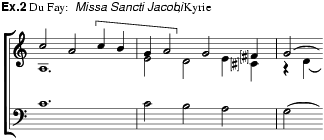
(It.: ‘changed note’; Fr. note de rechange; Ger. Wechselnote).
A type of Non-harmonic note. The term was introduced by Angelo Berardi (Miscellanea musicale, 1689) for an accented passing note, but after the publication of Fux’s Gradus ad Parnassum (1725) it came to mean an unaccented non-harmonic note quitted by leap of a 3rd downwards; when used on its own, the noun Cambiata has a different (though related) meaning.
Both the ‘Berardian cambiata’ and the ‘Fuxian cambiata’ are regular features of Palestrina’s style, the latter offering the only examples in his music of dissonances resolved by leap (ex.1). More recently the term ‘nota cambiata’ has been extended to include similar configurations used in the 15th and 16th centuries, as in ex.2, and to other figures in which two notes following a dissonance have been interchanged (‘note cambiate’) so that the dissonance is likewise quitted by leap of a 3rd, as in ex.3.



B. Ziehn: ‘Über die Cambiata und andere altklassische melodische Figuren’, AMz, xxv (1898), 497–8, 509–10, 525–6, 539–41
K. Jeppesen: Palestrinastil med saerligt henblik paa dissonansbehandlingen (Copenhagen, 1923; Eng. trans., 1927, 2/1946/R as The Style of Palestrina and the Dissonance)
C. Dahlhaus: ‘Die “Nota cambiata”’, KJb, xlvii (1963), 115–21
WILLIAM DRABKIN